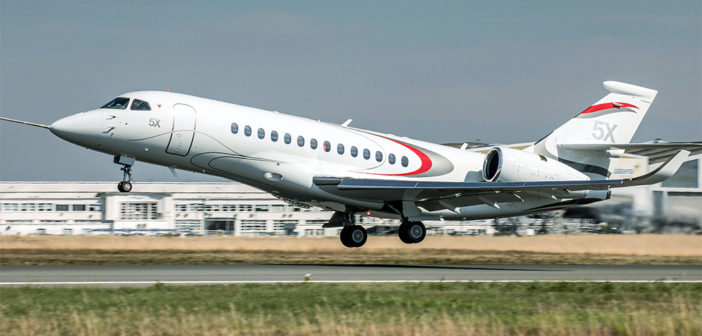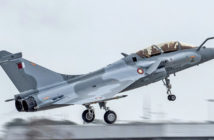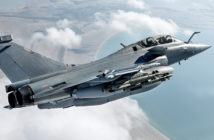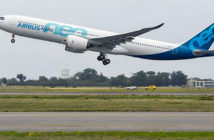Bordeaux-Mérignac, France, 5 July 2017) — With test pilots Philippe Deleume and Philippe Rebourg at the controls. Dassault Aviation’s all-new Falcon 5X made its first flight, allowing the ultra wide body twinjet to embark on a limited number of preliminary flight tests before the start of a dense flight test campaign, scheduled to begin next year.
The aircraft took off today from Dassault’s Bordeaux-Mérignac final assembly facility. The 2-hour flight was performed with a preliminary version of the Safran Silvercrest engines, because design issues and earlier conked out programme management have delayed the power plant development no less than four years beyond the initial timetable. The 11,450 and 12,000 lbf (50.9 and 53.4 kN) Silvercrest 2D and 2C turbofans will power respectively the Falcon 5X and the Cessna Citation Hemisphere, EASA certification is expected for the spring of 2018, followed by US certification by the FAA in August 2018.
This advanced flight test campaign is hoped to permit collection of a certain amount of airframe and systems data that could not be generated during a ground test campaign undertaken earlier this spring. The ground campaign included ground runs as well as low and high speed taxi tests. Let’s point out that the Falcon 5X is the first Dassault business jet to use French made turbofans. The brand-new engine was announced at the 2006 NBAA convention. Certification was originally slated for the end of 2010 or early 2011. The first test Silvercrest started ground testing in September 2012. In May 2013, in-flight trials were targeted for the fourth quarter of the year, but they finally began in July 2014 only using a Grumman Gullfstream II as a flying testbed. Due to persistent design problems, the 2015 deadline for the engine certification was re-scheduled for late 2016. In November 2016, issues were traced to airflow through the engine not as controlled as initially expected, a side-effect of the axial-centrifugal high-pressure compressor selection controlling software was adapted to maintain a steady airflow and active clearance controls were added to the low pressure turbine. Altitude tests on an Illyushin Il-76 tested should begin soon in Russia for an early 2018 certification.
The purpose of the present flight test campaign, which will last only a few week pending the certification of the Safran Silvercrest turbofan, is to help streamline the Falcon 5X development process. Flight validation and certification tests will be performed next year, once Safran delivers certifiable engines meeting Dassault’s specifications.
“We’re committed to limiting the consequences of the four year engine development delay as much as possible and the short preliminary flight test campaign is part of this effort,” said Eric Trappier, Dassault Aviation Chairman & CEO. “We will closely monitor the validation tests on the modified Silvercrest, which are scheduled by Safran in the few coming months, as their results will be critical for meeting the 5X entry into service in 2020”.
“Our customers are anxious to fly our new wide body Falcon”, continued Trappier. “Combined with the 5X’s new generation digital flight controls, the new ultra efficient wing will make it possible to blend the spaciousness and comfort of large cabin jets with the maneuverability, efficiency and airport capability of much smaller aircraft, establishing a new benchmark for the long range business jet market.”
The cabin of the Falcon 5X will be the tallest and widest in the industry. Yet the aircraft will land at a speed down in the turboprop range and have a fuel burn significantly lower than that of any other business jet in its class. Will the 5X build on the continuous success of the 7X trijet family? Only the future will tell. //




